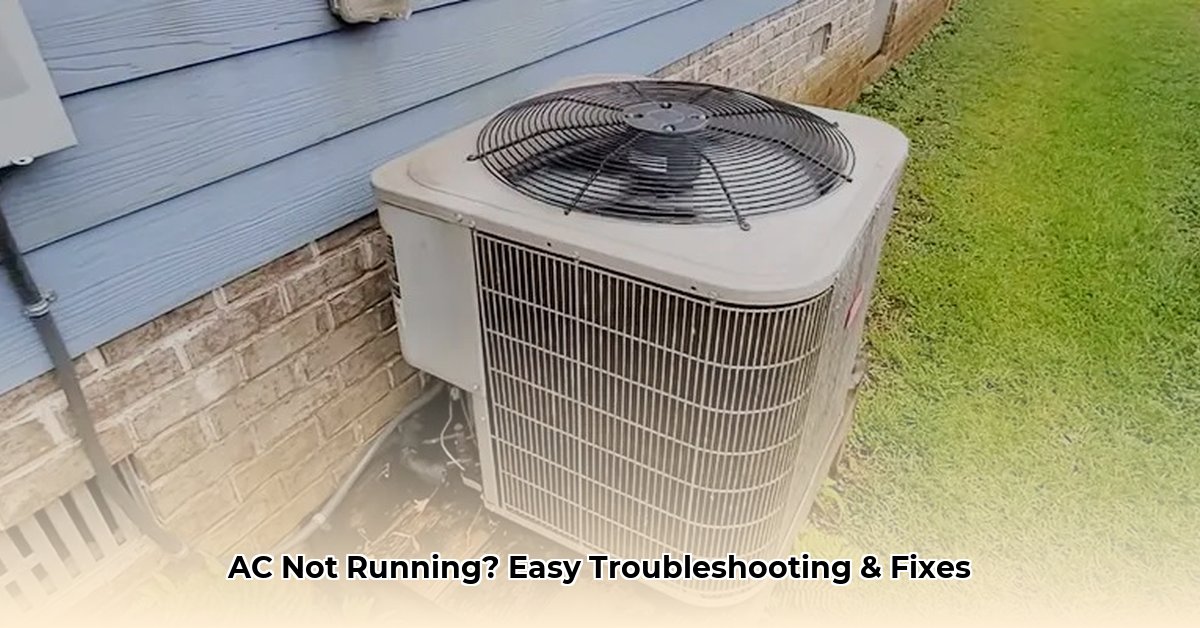Is Your AC Taking a Summer Siesta? Let’s Get It Back to Work!
A silent AC unit on a scorching day is a homeowner’s nightmare. But before you surrender to the heat, remember many common culprits behind a non-functional AC can be tackled with some simple troubleshooting. This guide will walk you through the most likely suspects, from easy fixes to situations where calling a pro is the best move.
First Things First: The Easy Checks
Before we delve into the inner workings of your AC, let’s start with the basics. These quick checks often resolve the issue without any tools or technical expertise.
Thermostat Troubles?
Surprisingly often, the solution is as simple as adjusting your thermostat. Verify it’s set to “cool” mode and the temperature is set lower than the current room temperature. If your thermostat is battery-powered, try replacing the batteries. A weak battery can sometimes disrupt communication between the thermostat and the AC unit.
Is Your AC Getting Power?
Like any electrical appliance, your AC needs power to run. Check the following:
- The Breaker: Locate the circuit breaker labeled for your AC unit in your electrical panel. If it’s tripped (the switch is in the middle or off position), flip it completely off and then firmly back on. If it trips again immediately, do not continue to reset it. This likely indicates a more serious electrical problem, and it’s time to call a qualified electrician.
- The Disconnect Switch: Many outdoor AC units have a dedicated shut-off switch, often a gray metal box located near the unit. Ensure this switch is turned “ON.”
The Reset Button: A Quick Reboot
Some outdoor AC units have a reset button, typically red and located on the unit’s panel. Pressing this button can sometimes resolve minor glitches. It’s worth a try!
Investigating Further: Airflow and Obstructions
If the basic checks didn’t revive your AC, let’s move on to potential airflow issues.
Give Your AC Some Breathing Room
Head outside and inspect your AC unit. Is anything blocking the airflow around it? Leaves, debris, overgrown shrubs – all of these can obstruct airflow and reduce your AC’s efficiency. Before clearing anything away, turn off the power to the unit at the breaker box.
Is Your Air Filter Clogged?
A dirty air filter restricts airflow and can lead to a variety of problems, including a frozen evaporator coil and reduced cooling capacity. Locate your air filter (usually in the return air vent inside your home) and check if it looks dirty. If so, replace it with a new one. This simple fix is often overlooked but can make a big difference.
Condensate Drain Line: Is It Blocked?
The condensate drain line removes condensation produced by the AC unit. A blockage can trigger a safety switch, shutting down the system. Locate the drain line (usually a PVC pipe) and check for any kinks or obstructions. If you find a clog, carefully try to clear it. If the blockage persists, call a professional.
Advanced Troubleshooting (Proceed with Caution!)
If you’re comfortable working with electricity and want to investigate further, there are some advanced troubleshooting steps you can take. However, we strongly recommend calling a licensed HVAC technician if you are unsure about any of these steps.
Inspecting the Capacitor
The capacitor, a small cylindrical component, helps start the AC’s motor. A failing capacitor can prevent the unit from running. Warning: Capacitors store an electrical charge. Discharge them safely before handling. Again, we strongly recommend calling a qualified technician if you are not absolutely sure what you’re doing.
Checking the Contactor
The contactor is an electrical relay that controls power flow to the compressor. A faulty contactor can also prevent the AC from running. Warning: Always disconnect the power to the unit at the breaker box before working on the contactor.
When to Call a Pro
While many AC issues can be resolved with simple DIY fixes, some problems require professional expertise. Call a licensed HVAC technician if:
- The breaker trips repeatedly after resetting.
- You suspect a refrigerant leak (ice on the unit, hissing sounds, or decreased cooling performance).
- You smell burning coming from the unit.
- You’ve tried all the basic troubleshooting steps, and the AC is still not running.
- You’re uncomfortable working with electrical components.
Prevention is Key: Regular AC Maintenance
Just like your car, your AC needs regular maintenance for optimal performance and to prevent future breakdowns. Consider scheduling an annual AC tune-up with a qualified technician. This preventative measure can help identify and address potential problems before they become major headaches.
Quick Troubleshooting Table
| Problem | Possible Cause(s) | DIY Potential |
|---|---|---|
| AC not turning on | Tripped breaker, disconnected switch, thermostat issues, no power | Yes |
| Fan not spinning | Obstruction, faulty capacitor, worn-out motor | Limited (obstruction check only) |
| AC running but not cooling | Low refrigerant, dirty coils, clogged condensate line, other internal issues | Limited (condensate line check only) |
By following this troubleshooting guide, you’ll increase the chances of getting your AC back online quickly. Remember to prioritize safety and don’t hesitate to call a professional when needed. Staying cool shouldn’t be a guessing game!
- How to Stop Apps From Running in the Background to Boost Your - December 1, 2025
- How To Move Apps On Your Droid For Better Organization - November 30, 2025
- How to Move Apps on Android for Better Organization - November 29, 2025










